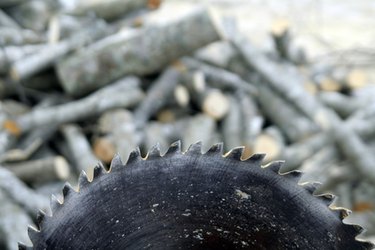Things You'll Need
Carbide-tipped saw blade
Dremel tool with diamond paddle hone attachment
Citrus oil soap
Basin or water container
Small brass-bristled brush
Safety goggles
Safety gloves

While the conventional wisdom surrounding carbide saw blades reserves sharpening for industry professionals, more and more individuals are choosing to touch up and care for their own blades at home. While most starter sets for sharpening can be purchased for $100 to $500, with fully professional kits nearing $5,000 in cost, anyone with a working Dremel tool and diamond paddle hone attachment can learn the basics of finishing and sharpening carbide saw blades.
Step 1
Decide on a working area with ample lighting for the cleaning and sharpening of your saw blade. Make sure that the working surface is clear of any dirt, dust or other debris.
Video of the Day
Step 2
Fill the basin or other water container with hot water while adding copious amounts of the citrus oil soap. Continue adding soap until the water surface is thick with soapsuds. Submerge each dull carbide saw blade in the basin and let it soak for 15 to 20 minutes. Once dry, carefully lift each blade and scrub out any resins or trapped oils between the blade teeth using a small brass-bristled brush. Repeat for each blade before rinsing the blades in hot water and setting them out to dry.
Step 3
Insert the diamond paddle hone attachment into the nozzle of the Dremel tool and wet the tip in soapy water. Put on your safety gloves and goggles and turn on the Dremel tool at a medium setting. Apply the wetted paddle hone tip to the flat steel sides of your carbide saw blade, re-wetting the tip if sparks occur. Continue finishing the saw faces until both blade surfaces display a uniform sheen and color.
Step 4
Hold the blade vertically in one gloved hand to position the saw blade for sharpening. Re-wet the paddle hone by dipping the tip in soapy water once more before carefully inserting it against the flat "leading" face of one of the carbide teeth. Turn on the Dremel tool to medium setting and apply the wet hone to each face of the carbide teeth, making sure not to round out the sides of the teeth as you work. Gently touch the tip of each tooth with the paddle hone to aid in cutting. Repeat for each of the carbide teeth until the blade has been entirely sharpened with the wet paddle hone.
Step 5
Rinse the completed blade in hot water and let dry before returning it to the saw. Repeat the process for any other carbide saw blades that require sharpening.
Tip
For individuals who may not have access to a Dremel, or other rotary hand tool, a grinding machine with a rotating diamond wheel can also be utilized to sharpen a carbide-tipped saw blade. Turn the grinding wheel on a low setting and gently press the sides and teeth of the saw blade into the wheel while wearing safety goggles and gloves.
Warning
Always wear safety goggles when working with power tools that may cause sparks. Also, handle each saw blade with care, even the dull blades—once the teeth have been cleaned of oils and resins, there may be some sharp teeth left along the bevel.
Video of the Day